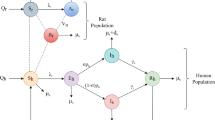Abstract
The concept of the natural nidality of human diseases has significantly changed during the last 70 years, but its essence is preserved. Many “new” infections with natural foci were discovered and their geographical distribution was investigated in detail, and the classification of natural foci was developed. It has been established that epidemic features of transmissible infections depend mainly on types of parasitism of insect, tick and mite vectors.
Similar content being viewed by others
References
Balashov, Yu.S., Ixodid Ticks, Parasites and Vectors of Infections (Nauka, St. Petersburg, 1998) [in Russian].
Balashov, Yu.S., “Bloodsucking Insects and Acarines, Vectors of Transmissible Infections of Humans and Domestic Animals,” Entomol. Obozr. 84, 677–691 (2005) [Entomol. Rev. 85 (8) 990–1007 (2005)].
Balashov, Yu.S., Parasitism of Acarines and Insects on Terrestrial Vertebrates (Nauka, St. Petersburg, 2009) [in Russian].
Korenberg, E.I., “Preadaptive Origin of Pathogens of Zoonoses with Natural Nidality,” Uspekhi Sovr. Biol. 125, 131–139 (2005).
Litvin, V.Yu. and Korenberg, E.I., “Natural Foci of Diseases. Development of the Concept to the End of the Century,” Parazitologiya 33, 172–191 (1999).
Lvov, D.K., Klimenko, S.M., and Gaidamovich, S.Ya., Arboviruses and Arboviral Infections (Nauka, Moscow, 1989) [in Russian].
Pavlovsky, E.N., “On Natural Foci of Infection and Parasitic Diseases,” Vestnik Akad. Nauk SSSR 10, 98–108 (1939).
Pavlovsky, E.N. Natural Nidality of Transmissible Infections (Nauka, Moscow, 1964) [in Russian].
Danielova, V., Holubova, J., Peicoch, M., and Daniel, M., “Potential Significance of Transovarial Transmission in the Circulation of Tick-borne Encephalitis Virus,” Folia Parasitol. 49, 323–325 (2002).
Eldridge, B.F., Scott, T.W., Day, J.F., and Tabachnic, W.J., “Arbovirus Diseases,” in Medical Entomology (Kluwer Publ., Dordrecht, Boston, London, 2000), pp. 415–460.
Gern, L. and Humair, P.F., “Ecology of Borrelia burgdorferi sensu lato in Europe,” in Lyme Borreliosis: Biology, Epidemiology and Control (2002), pp. 149–173.
Gratz, G.N., “Emerging and Resurging Vector-Borne Diseases,” Ann. Rev. Entomol. 44, 51–75 (1999).
Labuda, M. and Nuttall, P.A., “Tick-borne Viruses,” Parasitology 129(S), 221–245 (2004).
Noda, H., Munderloh, J., and Kurtti, T.J., “Endosymbionts of Ticks and Their Relationship to Wolbachia spp. and Tick-Borne Pathogenes of Humans and Animals,” App. Environ. Microbiol. 63, 3926–3932 (1997).
Randolph, S.E., “Tick Ecology: Processes and Patterns Behind the Epidemiological Risk Posed by Ixodid Tick Vectors,” Parasitology 129(S), 37–65 (2004).
Randolph, S.E. and Craine, N.G., “General Framework for Comparative Quiantative Studies on Transmission of Tick-borne Diseases Using Lyme borreliosis in Europe as an Example,” J. Med. Entomol. 32, 765–777 (1995).
Scoler, J.A., “Phylogenetic Analysis of the Francissella-Like Endosymbionts of Dermacentor Ticks,” J. Med. Entomol. 41, 277–286 (2004).
Telford, S.R. and Goethert, H.K., “Emerging Tickborne Infections: Rediscovered and Better Characterized, or Truly “New?” Parasitology 129(S), 301–327 (2004).
Author information
Authors and Affiliations
Corresponding author
Additional information
Original Russian Text © Yu.S. Balashov, 2009, published in Parazitologiya, 2009, Vol. 43, No. 5, pp. 355–360.
Rights and permissions
About this article
Cite this article
Balashov, Y.S. The 70th anniversary of E.N. Pavlovsky’s concept of natural nidality of human diseases. Entmol. Rev. 90, 533–536 (2010). https://doi.org/10.1134/S0013873810040123
Received:
Published:
Issue Date:
DOI: https://doi.org/10.1134/S0013873810040123




